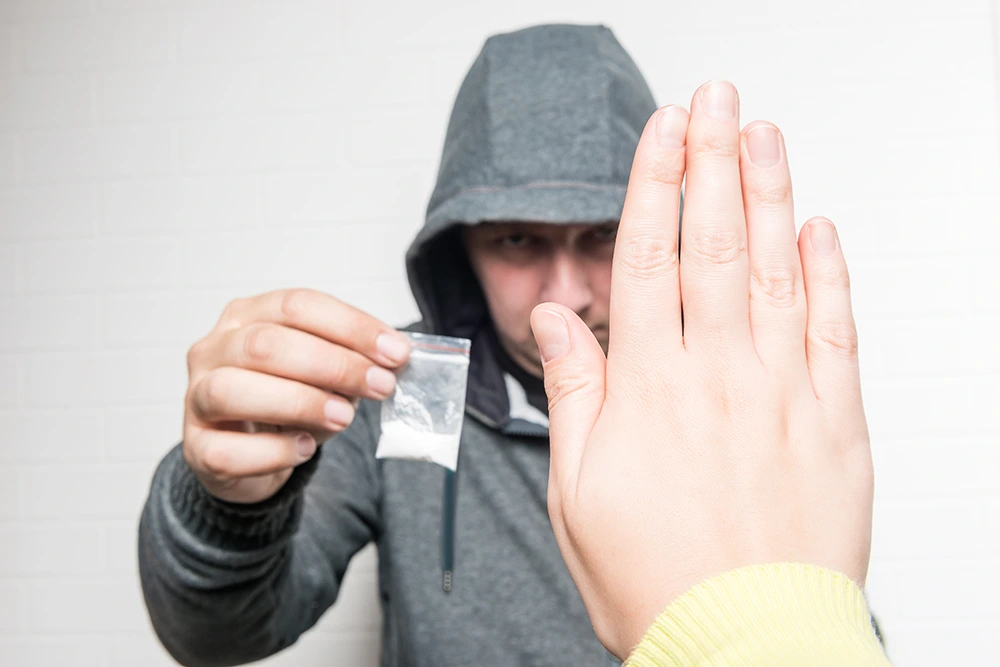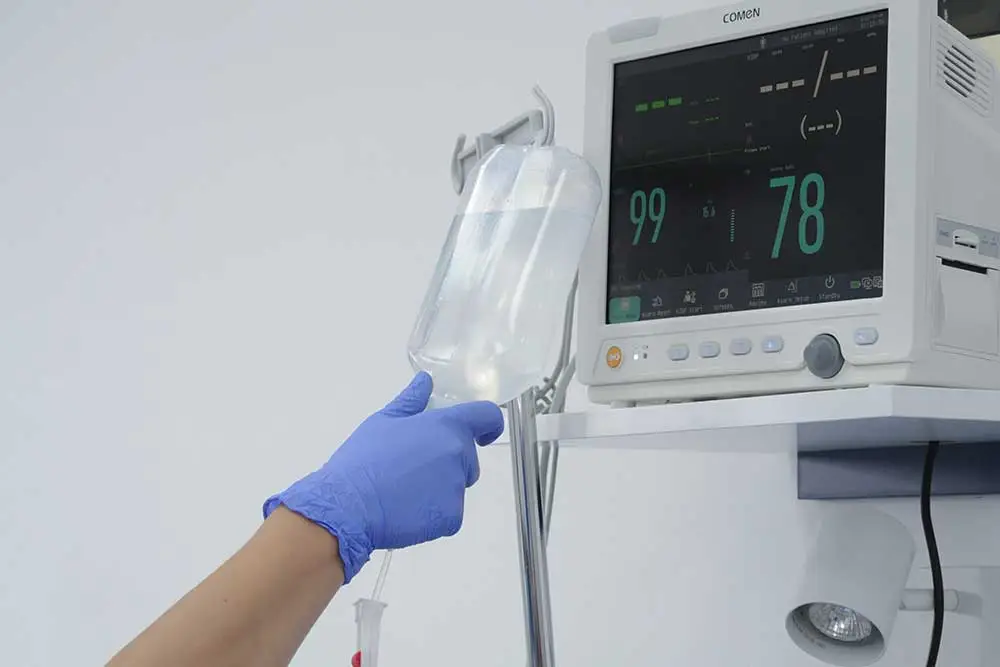Cocaine is an extremely powerful and highly addictive stimulant. For thousands of years, South Americans have chewed coca leaves, the source of cocaine, for their stimulant effects. The purified stimulant ingredient of this plant, cocaine hydrochloride, was isolated more than 100 years ago. In the early 1900s, purified cocaine was the main active ingredient in many tonics and elixirs made to treat a wide range of ailments. In the past, surgeons used cocaine to relieve pain. However, research has shown that cocaine is a powerfully addictive substance that can change the structure and function of the brain. That is why it is necessary to know how to recognize a cocaine addict. Cocaine looks like a fine powder and is white in color.
Today, cocaine is a class II drug, meaning it has a high potential for abuse, but it can be administered by a doctor for medical purposes, such as local anesthesia for some eye, ear, and throat surgeries. Sellers often dilute it with corn-starch, talcum powder, flour or baking soda to increase profits. They can also make fake cocaine using drugs such as procaine (a related local anesthetic) or amphetamine.
Cocaine is often combined with other psychoactive substances, most often with heroin. It is important to know how to recognize a cocaine addict, because this addiction requires immediate detoxification.
People abuse two chemical forms of cocaine: the water-soluble hydrochloride salt and the water-insoluble cocaine base. Users inject or snort the hydrochloride salt, or powder. If it is in powder form, addicts rub it into their gums.
The basic form of cocaine is made by processing it with ammonia or baking soda and water, then heating it to remove the hydrochloride, a smokable substance. So the crystal (cocaine) is heated to produce a vapor that is inhaled. This form of cocaine is called crack. It got its name from the crackling sound it makes as it heats up. Some addicts smoke crack like a cigarette by sprinkling it with marijuana or tobacco.
How to recognize a cocaine addict - What is cocaine addiction?
Cocaine is a highly addictive drug, and that is why it is important to have an answer to the question of how to recognize a cocaine addict. Constant craving for cocaine and ignoring its consequences are the first signs of addiction.
Psychological addiction is often the most difficult to overcome, although there are undeniable physical symptoms of addiction. Once addiction develops, tolerance develops and withdrawal symptoms will occur when use is stopped.
Once someone becomes addicted to cocaine, it can be very difficult to overcome the addiction. Cocaine causes a significant increase in dopamine levels in the brain, and after a while, reprograms the brain’s reward system.
In order to help someone with this problem, it is important to be able to recognize a cocaine addict.
More people are admitted to the emergency room for cocaine-related problems than for any other illicit substance.
Of the total number of admitted patients/addicts, as many as 68 per cent of them had more than one psychoactive substance in their body.
In 2020, more than 20,000 people overdosed on cocaine.
The largest number of deaths due to cocaine consumption occurred in persons aged between 35 and 44 years.
Precisely because of this, it is necessary to know how to recognize a cocaine addict, and therefore to be familiar with how a cocaine addict behaves.
Many people who experiment with cocaine generally do so in environments where other substances are also used. For this reason, many cocaine addicts may also have addictions to other substances, such as alcohol or marijuana. This is known as polydrug use and is particularly dangerous, as it increases the risk of overdose.
Cocaine and alcohol are often used together. Using heroin and cocaine together (known as “speedball”) is probably the most dangerous of all drug combinations involving cocaine. How a cocaine addict behaves depends a lot on what psychoactive substances that they have absorbed into the body.
The effect of cocaine – What it does to the brain and the body
The answer to the question of what cocaine does lies in its chemical composition. Cocaine causes addictive effects by acting on the limbic part of the brain. It is a set of interconnected parts that regulate the pleasure and motivation centers. The initial, short-term effect, a build-up of dopamine, causes euphoria and a desire to take cocaine again.
Cocaine affects brain cells in different ways. Some of the consequences of its effects quickly return to normal. Others last for weeks after the cocaine leaves the body. With repeated cocaine use, these short- and medium-term effects cumulatively lead to further side effects that last for months or years and may be irreversible.
In addition to increases in dopamine, cocaine use causes changes in the brain related to other neurotransmitters, including serotonin, gamma-aminobutyric acid (GABA), norepinephrine, and glutamate.

What does cocaine do to the brain?
Whether snorted, smoked or injected, cocaine quickly enters the bloodstream and penetrates the brain. What does cocaine do? This drug achieves its main immediate psychological effect by causing a build-up of the neurochemical dopamine.
Dopamine acts as a trigger for many nerve cells in the brain, and cocaine interferes with their natural functioning. It changes the neural circuitry in the brain that is fundamental to survival. Such changes affect the individual in a number of ways that scientists are still trying to understand.
Cocaine causes dopamine to build up wherever the brain has dopamine transporters. However, its ability to produce pleasure and euphoria, loss of control and compulsive reactions can be traced back to its influence in the front part of the brain that makes up the limbic system. Dopamine-responsive cells are highly concentrated in this area, which controls emotional responses and links them to memories.
One particular part of the limbic system, the nucleus accumbens (NAc), appears to be the most important site of action for cocaine. When stimulated by dopamine, cells in the NAc produce feelings of pleasure. The natural function of this response is to help us stay focused on activities that promote the basic biological goals of survival and reproduction. By artificially causing dopamine to build up in the NAc, cocaine provides extremely powerful feelings of pleasure.
The limbic system also includes important memory centers that help us remember what we did that led to pleasures. When someone experiences high levels of dopamine, these regions imprint memories of intense pleasure. That is one of the key answers to the question of what cocaine does.
The third limbic region, the frontal cortex, is where the brain integrates information and weighs different courses of action. The frontal cortex acts as a brake on other regions of the limbic system when we decide to forgo pleasure in order to avoid its negative consequences. When someone becomes addicted, the frontal cortex becomes damaged and the addict is less likely to overcome harmful urges.
How to spot a cocaine addict –Signs and symptoms of addiction
Cocaine/crack is a stimulant drug that makes a person feel euphoric. At the same time, cocaine is one of the most addictive drugs in the world. That is why it is important to know how to recognize a cocaine addict, in order to provide them with help as soon as possible.
A cocaine addict, while "on cocaine", feels:
- Extremely strong energy,
- Is sensitive to touch, light or sound,
- Is restless,
- Irritable,
- Often feels paranoid.
Physical and behavioral signs of cocaine use include:
- Dilated pupils,
- Increased body temperature and blood pressure,
- Faster heart rate,
- Loss of appetite,
- Unpredictable behavior.
Symptoms of cocaine overdose are:
- Breathing difficulties,
- Chest pain,
- Nausea or vomiting,
- Confusion, seizures, tremors,
- Anxiety,
- Panic,
- Paranoia.
Drug addiction implies its compulsive use despite the risks and consequences.
How to recognize a cocaine addict - if they exhibit some of the following signs:
- Sleep pattern changes,
- Ignoring hygiene,
- Secrecy,
- Often telling lies,
- Risky behavior,
- Frequent mood swings,
- Paranoia,
- Loss of interest in activities that previously gave them pleasure,
- Financial problems.
Detoxification from cocaine can cause:
- Intense cravings,
- Depression,
- Suicidal thoughts,
- Irritability,
- Fever.
It is extremely important to know how to recognize a cocaine addict, because in addition to the higher chance of death or complications from a drug overdose, cocaine abuse causes significant long-term health damage.
The long-term effects of cocaine abuse include:
- Nosebleeds,
- Loss of sense of smell,
- Swallowing problems,
- Asthma,
- Respiratory infections,
- Infections such as pneumonia, HIV, hepatitis C and airborne diseases are more likely to occur.
In addition, long-term use of cocaine can have negative effects on the addict’s heart. Damage to the myocardium, as well as other heart diseases, are common.
Cocaine use, as already explained, also affects the brain, and dementia is common.
Now that you know how to recognize a cocaine addict, it is important to notice the signs on time, and approach the addict gently and carefully. Do not judge, criticize or scold them. Individual addicts often feel isolated, lonely, helpless and hopeless. Let them know that you are able to help them find the support and help they need.
What is the behavior of a cocaine addict?
In order to realize how to recognize a cocaine addict, it is important to first know how a cocaine addict behaves. Since cocaine is a stimulant, it generally causes the user to be very talkative, energetic, and confident.
In addition, it creates a sense of well-being, which can make addicts more social, exciting and even more sexual. People on cocaine may appear “pumped up” for no apparent reason. How does a cocaine addict behave – paranoid, overly aggressive, has difficulty reasoning, is delusional and often hallucinates.
How a cocaine addict behaves also depends on how much of this drug they have taken. In addition, as cocaine is often used in combination with other psychoactive substances, how a cocaine addict behaves also depends on what else they have used besides this drug.
Cocaine is often mixed with alcohol, marijuana, and heroin. It is very certain that a cocaine addict will constantly exhibit a great amount of energy, euphoria and irrationality.

What type of problem can occur regarding the nose of the cocaine addict?
A cocaine addict’s nose can show many problems that cocaine addicts face, from bleeding to life-threatening infections.
Damage to the nose, nasal mucosa and sinuses occurs after snorting cocaine. This drug reduces the amount of blood that the brain sends to the nose. This process deprives nasal cells of oxygen, potentially damaging or killing them.
The nose of a cocaine addict and a sinus infection. Cocaine use increases the risk of sinus pain and sinus infections because cocaine irritates the nose and sinuses. Cocaine can cause serious sinus infections that spread to other parts of the body. Necrotizing sinusitis is a type of infection that spreads rapidly and kills cells, potentially damaging the nose, sinuses and surrounding organs, such as the eyes. If left untreated, it can be fatal.
Perforated septum. This disease is relatively common among cocaine addicts. It occurs due to reduced blood supply in the nose and the cells die. The septum is a collection of bones, cartilage and tissue that divides the nose into two halves. A septum can change the shape of the nose, cause serious breathing problems, and lead to chronic infections and pain. In some cases, damage to the septum can reduce support in the nose, destabilizing it and causing the nasal organ to collapse. This makes breathing difficult and causes further complications.
Bloody or runny nose. Cocaine addicts often have a runny nose, and bleeding is not uncommon. Regular use of cocaine damages blood vessels, narrows them and changes bleeding patterns.
Cocaine addict’s nose and breathing problems. Cocaine abuse increases the risk of several breathing problems. Cocaine users also have a higher risk of developing asthma, chronic obstructive pulmonary disease (COPD), and pneumonia. Cocaine can lead to chronic damage to the airways, which can result in lung collapse, bleeding in the alveoli, and numerous other complications.
Cocaine addicts pupils – What are cocaine eyes?
Cocaine abuse among young adults between the ages of 18 and 25 is relatively high. Many young people are exposed to a variety of risks, including violent behaviour, addiction and health risks. Therefore, it is important to know how to recognize a cocaine addict so that you can help those who need help. One of the negative consequences that cocaine causes is a phenomenon known as cocaine addict’s pupils.
Substance abuse directly affects the central nervous system. Cocaine, in particular, causes physical negative effects on the eyes of addicts. This phenomenon is called “cocaine eyes”.
Cocaine addict pupils, also known as cocaine eyes, refer to the appearance of the pupils after the consumption of cocaine. Cocaine dilates the pupils and makes them appear larger. Because cocaine is a stimulant, it stimulates the release of endorphins and other chemicals in the brain in large quantities.
When the pupils dilate, they become sensitive to light. Therefore, wearing sunglasses when it is not light can be an indicator of cocaine use. This is also how you can recognize a cocaine addict.
In addition to dilated pupils and sensitivity to light, the eyes may appear bloodshot or red. This is a common phenomenon that occurs in cocaine addicts. Dilation of the blood vessels in the eyes is also a key factor in the color change. How to recognize a cocaine addict – you may notice irregular or unfocused eye movements.
Pupils of the cocaine addicts and eye diseases
Cocaine can cause serious damage to vision and eyes. Also, it can cause long-term negative effects depending on the way of use and affect the pupils of cocaine addicts.
Jaundice. Excessive use of cocaine will damage the liver, leading to jaundice and, over time, potentially liver failure.
Nystagmus (flickering of the eyes, rapid eye movement). Nystagmus results in permanent abnormal eye movements. It can occur in one or both eyes. Cocaine causes this disorder by damaging the muscles, nerves and brain tissue associated with eye control.
Glaucoma. Cocaine users often suffer from glaucoma. Because cocaine affects blood pressure, it leads to a long-term increase in eye pressure.
Keratitis, diseases of the cornea. Cocaine can numb the eye. The blink reflex is suppressed and thus dries out the eyes. Foreign particles and fumes can easily scratch the surface of the eye or kill cells, leading to scarring, ulcers and permanently blurred vision.
Retinopathy. Cocaine use can lead to the accumulation of yellow-white crystalline deposits in the retina. These blockages often cause serious health problems such as blindness.
If you pay attention to these details, you will be able to recognize a cocaine addict.
How to know if a person is using cocaine – Spotting the early signs
Cocaine is a highly addictive amphetamine and this is one of the main reasons why it is important to know if a person is using cocaine. Addicts desperately need help to get their lives back on track, and primarily family and friends need to help them do that.
Common early signs by which you can know how to recognize a cocaine addict are:
- Weight loss,
- Runny nose,
- Mood changes,
- Risky behaviors,
- Increased confidence,
- Talkativeness,
- Secrecy,
- Financial problems,
- Burn marks on hands and lips.
While cocaine is addictive, its derivative, crack cocaine, is even more devastating. This highly concentrated form of cocaine is cheaper than cocaine and more addictive. Some people will become addicted to crack after the first use. How to tell if a person uses cocaine – pay attention to the small details that indicate it.
Also, cocaine and crack cocaine differ in the way they are consumed. While cocaine is snorted, because it is in powder form, crack is smoked.
Since crack is highly concentrated cocaine, and much cheaper, it is more difficult for addicts to give up consumption. Many people who become addicted to cocaine will turn to crack because it’s cheaper. After heroin, crack is the most harmful and highly addictive drug.
Cocaine abuse is never without consequences.
How to recognize a cocaine addict – Some of the early signs of cocaine addiction are:
- Cocaine is expensive. Pay attention to the finances of the person you suspect is addicted,
- Drastic changes in behavior,
- Excessive excitement and showing unrealistic self-confidence,
- Increased alertness to the point of insomnia,
- Fast or unbalanced speech,
- Dilated pupils,
- Delusions and hallucinations,
- Irritability or sudden mood swings,
- Changes in heart rate and blood pressure,
- Nasal congestion and mucosal damage.
How to know if a person uses cocaine – pay attention to their behavior.
How to recognize a cocaine addict and how to help them?
It is important to have an answer to the question of how to recognize a cocaine addict so that you can see the signs on time and help a friend or loved one.
Therapy and support, as well as the care of family and loved ones, play a large role in recovery from cocaine addiction. Besides getting the addict into the necessary treatment program, there are many things you can do. Helping to prevent relapse by being aware of potential warning signs and triggers that may have led to cocaine abuse is just one of them.
Family counseling can be very helpful in restoring healthy family dynamics and understanding each person’s role in recovery. Also, physical health can help promote mental health. In addition, teach other family members how to recognize a cocaine addict.
Being supportive, positive, and patient, while being mindful of your own needs during recovery, can go a long way toward improving your relationship with a family member who has developed an addiction.
Educate yourself about the disease of addiction, especially the mental and physical effects of cocaine abuse, as well as potential treatment options.
Be patient and persistent with the cocaine addict. Explain that you do not support the cocaine addiction, but you do support him or her.
Set boundaries and be consistent in maintaining them.
Help the addict understand the way addiction affects everyone around them.
However, the key to starting a conversation about treatment and addiction can be aided by the input and experience of a trained addiction treatment professional. Then you will definitely know how to help a cocaine addict.
How to recognize a cocaine addict - Cocaine addiction treatment
In 2013, cocaine caused addiction in nearly 6 per cent of people enrolled in drug addiction treatment programs. The majority of individuals (68 per cent in 2013) seeking cocaine treatment are crack and polydrug users. It is important to know how to recognize a cocaine addict, but also to know that drug addiction is a complex disease that involves changes in the brain, as well as a wide range of social, family and other environmental factors. Therefore, cocaine addiction treatment must address this broad context, as well as any other mental challenges that occur simultaneously.
Many behavioral treatments for cocaine addiction have been shown to be effective in both residential and outpatient settings. Indeed, behavioral therapies are often the only available and effective treatments for many drug problems, including stimulant addiction. However, integration of behavioral and pharmacological treatments may ultimately prove to be the most effective approach.
The clinic for the treatment of addictions from Belgrade, the MedTiM clinic, gathers first-class experts who can help cocaine addicts to effectively stop using this drug.
We are located on the outskirts of Belgrade, and in the treatment of addiction we use the most modern treatments and technologies.

For a healthy life–MedTiM Clinic
The most reliable addiction treatment clinic in Serbia, MedTiM, is made up of numerous experts who not only effectively treat addictions, but can also help you learn how to recognize a cocaine addict.
Our doctors and entire staff are available to all patients 24 hours a day and 7 days a week. The treatments we apply in the treatment procedures are adapted to each patient individually.
When the patient comes to the hospital, they are first referred to a psychiatrist. A confidential conversation takes place with the aim of taking the personal and family history of the disease, as well as for the doctor to get to know the patient. It is important to see the whole situation and all the difficulties immediately.
After that, the patient is sent for laboratory analysis. A biochemical analysis is carried out, a blood sample is taken, as well as an extended analysis if there is a suspicion of a harmful disease.
After the obtained analyses, the patient is referred to an internal medicine specialist who will subsequently determine whether there is a need for further specialist examinations. They can include ultrasound of the abdomen and heart, ECG and the like.
The patient’s therapy begins with psychotherapy with psychologists and special pedagogues and psychotherapists. In order to effectively carry out the treatment, it is necessary to immediately act on the psychological dependence on cocaine. Through psychotherapy work, different views of life after treatment, as well as of the past, from a different perspective, are developed. Meditation is performed, and sometimes, depending on the needs, drugs are used during the treatment.
It is a combination of a psychotherapy session with an intravenous infusion of a transmitter. This increases the potential of psychotherapy in which a psychologist or special pedagogue has a suggestive effect on the addict’s subconscious with the help of medication.
MedTiM’s staff, which consists of top specialists, as well as nurses and technicians, educates addicts and their families. It is important to know how to recognize a cocaine addict (cocainomane come riconoscerlo), but also the triggers from everyday life that lead them to consume intoxicating substances. In this way, the treatment is effective and without recurrence.
How to recognize a cocaine addict - Cocaine detoxification at the MedTiM clinic
After you realize how to recognize a cocaine addict and succeed in doing so, it is important to begin addiction treatment. Cleansing the body of cocaine is done using modern and effective methods.
The patient is referred for plasmapheresis, and metabolic infusions are also available, which significantly reduce the symptoms and effects of cocaine detoxification. In addition, massage and lymphatic drainage, as well as treatment in the salt room, are available to patients.
In addition, the MedTiM clinic also offers regenerative treatments, such as a hyperbaric chamber, oxygen LED SPA capsule, infrared sauna and others.
A healthy life is always available to you with MedTiM. Contact us and start the change. We know exactly how a cocaine addict behaves and we can help them.
Life without drugs is possible!



